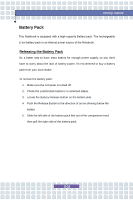MSI EX710 User Manual - Page 31
Left-side View
 |
View all MSI EX710 manuals
Add to My Manuals
Save this manual to your list of manuals |
Page 31 highlights
Getting Started Left-side View w v uu 1. USB Port The USB 2.0 port allows you to connect USB-interface peripheral devices, such as the mouse, keyboard, modem, portable hard disk module, printer and more. 2. Optical Storage Device A slim super-multi drive is available in the computer, depending on the model you purchased. The optical device allows you to use the CD/DVD disc for installing software, accessing data and playing music/movie on the computer. 3. DVB-T Port (Digital Video Broadcasting-Terrestrial) (optional) DVB-T is an acronym for Digital Video Broadcasting - Terrestrial and means basically the (mostly used in Europe) digital TV broadcasting method that's done via terrestrial networks -- normally existing analogue TV antennas are used to receive the transmissions 2-13















